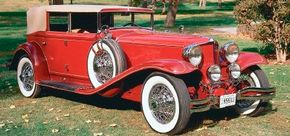It's been said that one can avoid criticism only by saying nothing, doing nothing, and being nothing. Errett Lobban Cord avoided those pitfalls and was criticized a lot.
He jumped from car salesman in 1924, to president and chief stockholder of Auburn in 1926. At age 31, he was the youngest president of an American automaker. By the early '30s he'd also acquired Duesenberg and many other enterprises.
Advertisement
His method was only too clear: dump large amounts of common stock until its value was so low that he could buy controlling shares for a song. Cord's empire included aviation, shipping, taxicabs, among other interests.
While distracted by these other ventures, Cord's auto companies suffered. Heavy losses forced Cord to sell his holdings in 1937. Auto production was the first to be shut down by the new owners. Some enthusiasts have never really forgiven him for that.
During 10 years of wheeler-dealer success, E.L. Cord was behind some of the most-magnificent cars ever built. In 1928, he ushered in the beautiful Auburn Speedster. The following year introduced the mighty Duesenberg Model J and the Cord L-29. The last proved less than hoped for, but it led to the 1936-37 Cord 810/812, one of the most-memorable and influential cars of all time.
The unbridled optimism of the late '20s prompted many new models and a few new makes to fill specific market niches. E.L. Cord decided to fill the price gap between his eight-cylinder Auburns and exotic Duesenbergs with a rakish new car bearing his own name and the then-novel feature of front-wheel drive.
The resulting L-29 was chiefly engineered by race-car builder Harry Miller and one Cornelius Van Ranst, both avid proponents of "horse-pulls-cart." Its powerplant began as the 298.6-cubic-inch Auburn straight eight, but ended up quite different.
For the Cord's front drive it had to be mounted backward so that clutch and transmission could face forward. The cylinder head was altered to put the water outlet up front, and the crankcase was modified for a rear engine mount. According to one Cord authority, the L-29 engine had over 70 unique parts. Advertised at 125 horsepower, its actual output was 115 until 1932 when a larger bore increased horsepower to a truthful 125.
Sending its power to the front wheels was a three-speed sliding-pinion gearbox mounted behind the differential as on a Miller-designed 1927 Indianapolis racer. Front brakes were mounted inboard, against the differential instead of on the wheels. This reduced unsprung weight for improved ride and handling. Quarter-elliptic leaf springs appeared fore, semielliptics aft, Houdaille-Hershey shock absorbers all around. Driveshafts employed premium Cardan constant-velocity universal joints.
This layout was not without problems. The main one was excessive drivetrain length that dictated a tremendous 137.5-inch wheelbase, yet put more than half of the car's weight over the rear wheels -- where it did nothing for traction on hills, icy roads, or gravel surfaces.
Worse, the U-joints couldn't stand braking, plus the pounding of wheels that drove as well as steered, and they wore out with merciless frequency. Though these problems could have been licked with time, Cord was adamant that the car debut before 1930 (which it did, though only by six months).
But, oh, what that layout did for looks. The super-long front allowed Auburn chief designer Al Leamy (with help from body engineer John Oswald) to craft a flowing hood/fenders ensemble that only accented that impressive length and the lowness conferred by front-wheel drive. Capping the front end was a sheetmetal grille completely enclosing the radiator -- an industry first.
In all, the L-29 looked sensational in its four "factory" body types: sedan, brougham, phaeton, and cabriolet, all supplied by subsidiary Cord companies. Numerous celebrities bought L-29s, and coachbuilders at home and abroad created stunning custom bodies. Standard models were fairly priced in the $3100-$3300 range, so the L-29 should have been a success.
It wasn't. Even without the poor traction and U-joint woes, front drive was an unproven commodity and thus a tough sell in the conservative $3000 market. And late 1929 was hardly the best time to launch any car, what with Wall Street types launching themselves out of windows.
Furthermore, compared to contemporary Packards, Lincolns, and Cadillacs, the L-29 was a slug. Its 0-60 time was around 25 seconds, top speed barely 75 mph. One writer euphemistically termed this "pleasant tepidity," and it was almost excusable given the brilliant styling.
But there was no way the L-29 could make money. It thus limped along through 1932 with virtually no changes. Total production came to 5010. By 1935, one used-car guide listed the cash value of the L-29 convertible at just $145. Although a failure in its time, the L-29 has since been widely appreciated -- including certification as a Classic by the Classic Car Club of America.
For more on defunct American cars, see:
- AMC
- Duesenberg
- Oldsmobile
- Plymouth
- Studebaker
- Tucker
Advertisement

